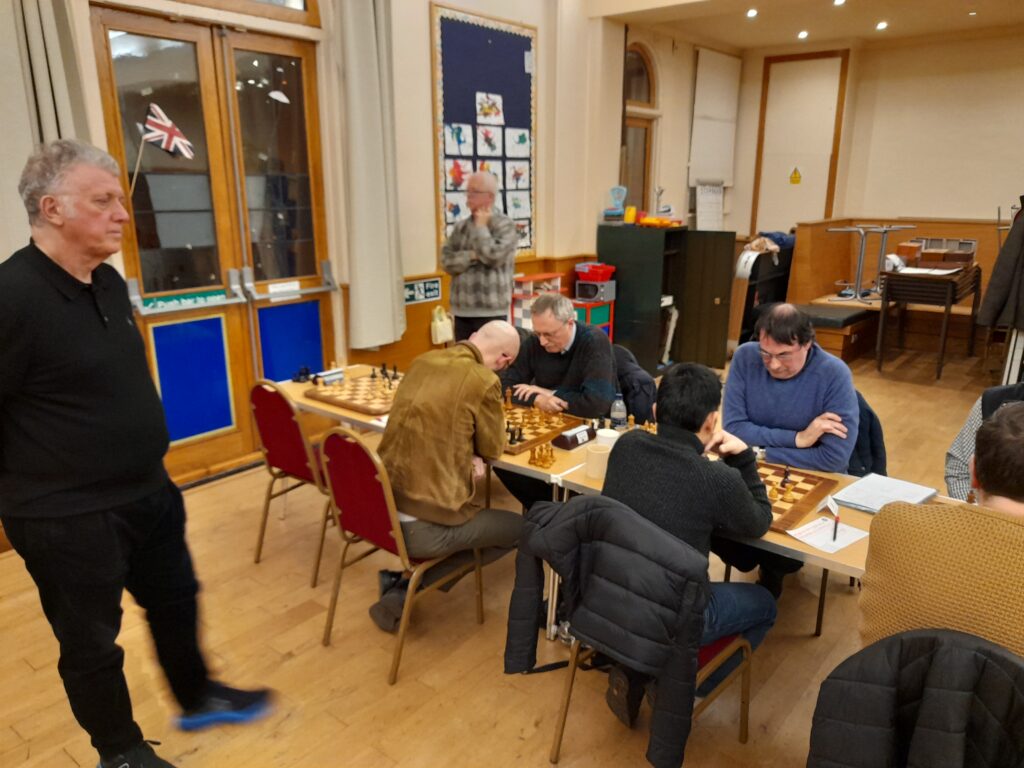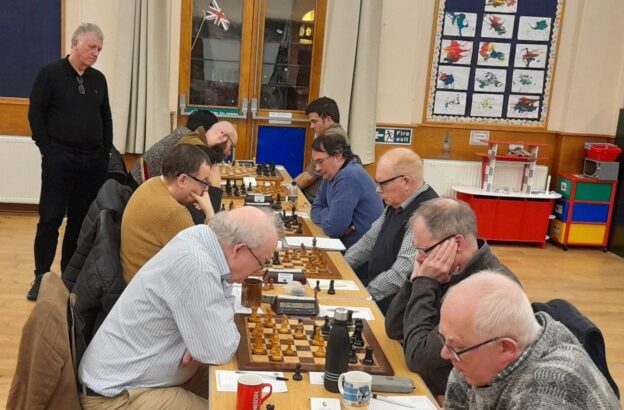Thames Valley division 1 match played at St Winefride’s Church Hall, Wimbledon on 1 February 2024
Wimbledon captain Ian Heppell said before the start of the match that this was the strongest Thames Valley League team they had turned out this season. They had IM Alberto Suarez Real on board 1, and, although Kingston had a rating advantage on the other five boards, they all looked likely to be tight.
One privilege enjoyed by Kingston members is Vladimir Li’s occasional series of lectures on positional chess, a key message from which is that positional and routine chess are very different things; even in quiet openings, players must be alert to tactical opportunities which can destroy the positional build-up. My game against Neil Cannon on board 5 illustrated this nicely. Black slightly mixed his plans by playing b6, which weakened his knight on c6, and then not following up immediately with Bb7. After nine moves, he was already lost.
With that quick goal in the net, Alan Scrimgour dodged a bullet against Tony Hughes (who was in form, having won the first Kingston Blitz at All Saints Church the previous day). After playing against Tony’s English much as he would as White against a Sicilian, Alan had launched a queenside foray with his queen and rook. For a moment, in the position below, White had the chance to win the exchange:
White could have played 17. Ndb1 and won the trapped rook for his knight. Fortunately – for Kingston at least – he missed the backward step (a common theme in my reports), Alan extricated himself, and a draw was soon agreed as simplification was about to occur.
Next to finish was Vladimir Li, who had White on top board against Suarez Real. After a King’s Indian Defence, Vladimir’s 16th move prompted an interesting debate later among the Kingston players:
Vladimir went with 16. Qb3. Black’s queen is his most active piece, defending several weak spots. Although after 16…Qxb3 17. axb3, the b-pawns are doubled, Black cannot get at them, and the semi-open a-file may be of use. Stockfish suggests 16. Qd2 as the best move – 16…Rac8 17. Be3 Qa5 18. Bf4 Qb6, but the evaluation (level) is the same. Vladimir was concerned that if the black queen was not challenged, Black could reorganise, moving his queen’s bishop to f5 and knight to d7 or e4 (though in such a line he would have to ensure that g4 would not win the bishop).
In the game, Vladimir got the sort of position the late world champion Tigran Petrosian would have loved, in which, although he had no immediate breakthrough himself, Black had no useful way to activate himself, and instead retreated his knight to e8 and bishop to f8 to hold the weak d6 point. Vladimir had a substantial time advantage as well, so the IM could not reasonably turn down a draw; clearly a good result for Kingston on the one board where we had a rating disadvantage.

Boards 2, 3 and 4 went the distance. On board 3, Silverio Abasolo had an early edge with White against Dan Rosen. In the position below, both sides must have missed that White had two ways to get a significant advantage:
The best move might be 15. Qe3, attacking the a-pawn. If 15…Kb8 16. e5 dxe5 17. Rxd8+ Qxd8 18. Qxe5+ wins, so White will win the d-pawn. If 15…b6, White can play a move which is the more daring option anyway: 16 Rxd6!, and after 16…Rxd6 17. e5 the fork wins back the rook, leaving White a pawn up.
After that, Black took the initiative. In this position, he perhaps “played for two results” by going for a slightly better ending rather than leaving the queens on:
30…Qf6 would have left White suffering: 31. Bg2 Rde8 32. Qd2 Nb6 threatens Nc4 and unbelievably the queen would be trapped in her own backyard, and White would have to give up the exchange. So 33. b3 is necessary, and White has multiple problems: the front rook is almost trapped, and Black threatens to land on f2, or pick off the weak white pawns. Instead he played 30… Qxe2. After 31. Bxe2 Rf2 32. h4 gxh4 33. Rh1 c5 34 Rd2 d4 35. Nd1 was a surprisingly effective defence. Pieces were exchanged, Silverio recovered his pawn, and in the final position (below) his passed pawn more than compensated for his less solid pawn structure and a draw was agreed.
For a long time, spectators found it difficult to evaluate Julian Way’s position against Ian Heppell on board 4. In the position that arose after 14…fxe6, which both sides had allowed voluntarily, were his doubled pawns sufficiently compensated by the two bishops, the extra open file and a central pawn mass?

Vladimir aptly described Peter Lalić’s game on board 2 against Russell Picot as “flowing like music”. Most of Peter’s games this season have started with him allowing an early queen exchange on d8 or d1. His opponents are attracted to preventing his king from castling, and probably by the thought that with queens off they improve their chances of a draw against a highly rated player. But this can be an illusion. Queenless middle games can require precision, and Peter has far more experience of handling such positions than most of his opponents will ever have. As in Julian’s game, there was an important point at which the two players allowed a sequence of moves which they must have evaluated differently.

A tremendous win by Peter to complete an excellent night for Kingston. It felt like a return to the “steamroller” first team of last year and propelled Kingston to the top of Thames Valley League division 1, though Hammersmith in second place have three matches in hand and must be warm favourites to win the title. Still, we were greatly encouraged by this performance, and enter the second half of the season in good heart.
Peter Andrews, Kingston 1 Surrey League captain and captain on the night in this match


